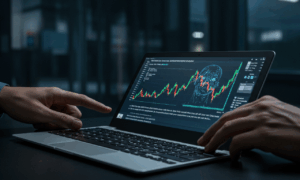A significant investment development is stirring the waters of the U.S. financial landscape with the recent announcement of plans for the Texas Stock Exchange (TXSE). This ambitious venture, reportedly backed by financial giants BlackRock and Citadel Securities among others, aims to create a new, prominent venue for companies to list their shares and for trading to occur. For those keen on understanding the evolving world of investing and market structures, this news offers a fascinating glimpse into potential shifts. This article will deconstruct what the emergence of the TXSE could signify, explore the underlying factors, and explain its potential implications, all while emphasizing that this information is for educational purposes and not financial advice. We aim to provide you with relevant information to better understand changes in the financial markets, similar to other updates you might find on our Home page.
What is This New Texas Stock Exchange All About?
The core of the news is that a group named TXSE Group Inc. has announced it has raised approximately $120 million. The objective of this capital infusion is to establish and launch the Texas Stock Exchange, based in Dallas. The primary goals are twofold: to attract corporate listings, meaning companies choosing TXSE as the official marketplace for their shares, and to provide a robust, modern electronic platform for the trading of these securities. The involvement of major players like BlackRock, one of the world’s largest asset managers, and Citadel Securities, a leading global market maker, lends significant weight and credibility to this initiative. While these firms are providing initial capital, the exchange aims to operate as an independent entity, seeking to carve out its own niche in the competitive U.S. exchange landscape currently dominated by the New York Stock Exchange (NYSE) and Nasdaq.
The Objective Data: What We Know So Far
While the project is still in its formative stages, some key details have emerged:
- Funding: As mentioned, the initial capital raise is around $120 million from a diverse group of over two dozen investors, including the aforementioned financial heavyweights.
- Leadership: The initiative is being spearheaded by James Lee as CEO, who brings experience to this complex undertaking.
- Timeline: The roadmap suggests a phased approach. The TXSE group is aiming to file for registration with the U.S. Securities and Exchange Commission (SEC) later this year. If regulatory approvals are granted, they anticipate facilitating their first trades in 2025 and accepting company listings by 2026.
- Location: Dallas, Texas, has been chosen as the physical headquarters, reflecting the state’s growing economic prominence.
- Strategic Focus: The TXSE is positioning itself as a “CEO-friendly” and “issuer-friendly” exchange. This suggests an intention to potentially offer more flexible listing standards, perhaps challenging what some perceive as increasingly burdensome compliance costs or specific mandates associated with existing major exchanges. It aims to be fully electronic, aligning with modern trading practices.
Why Texas? Why Now? Deconstructing the Motives
The decision to establish a new stock exchange in Texas at this particular juncture is driven by a confluence of factors. Understanding these motivations helps to appreciate the potential significance of the TXSE.
Firstly, Texas’s economic boom is undeniable. The state has seen substantial growth, attracting numerous corporate relocations and fostering a vibrant business environment. This creates a local ecosystem of companies that might find a Texas-based exchange appealing for raising capital and listing their shares. The argument is that the center of economic gravity in the U.S. is shifting, and financial infrastructure should follow.
Secondly, there’s a perceived demand for alternatives to the established exchanges like the NYSE and Nasdaq. Some business leaders and companies have expressed concerns over the increasing complexity of listing requirements, the costs associated with being a publicly traded company on these platforms, and, in some quarters, pushback against certain corporate governance trends or ESG (Environmental, Social, and Governance) disclosure pressures. The TXSE may see an opportunity to cater to companies looking for a different approach, potentially one that is less prescriptive or perceived as more aligned with certain business philosophies.
Thirdly, technological advancements have lowered the barriers to entry for creating new exchanges. Modern electronic trading platforms can be developed and deployed more efficiently than in the past, making the prospect of launching a competitive exchange more feasible, provided there’s sufficient capital and a compelling value proposition.
Finally, the backers likely see a strategic opportunity to capitalize on these trends, fostering competition which can often lead to innovation and potentially better terms for companies seeking to list and investors participating in the markets. It’s a calculated investment in market infrastructure itself.

How Stock Exchanges Work: A Quick Primer for Beginners
For those new to investment concepts, a stock exchange might seem like an abstract entity. At its core, a stock exchange is an organized and regulated marketplace where financial instruments, primarily stocks (also known as shares or equities), are bought and sold. Think of it as a highly sophisticated auction house or a digital bazaar for company ownership stakes.
Their primary roles include:
- Capital Formation: Exchanges provide a platform for companies to raise capital. When a company “goes public” through an Initial Public Offering (IPO) or issues additional shares, it does so via an exchange. This capital can then be used for expansion, research, debt repayment, or other corporate purposes. This is a vital part of the broader Economy, fueling growth and innovation.
- Price Discovery: The continuous buying and selling activity on an exchange helps to determine the fair market value of a company’s shares based on supply and demand.
- Liquidity: This is a crucial concept. Liquidity refers to the ease with which an asset (like a stock) can be bought or sold quickly without causing a significant change in its price. Exchanges provide liquidity by bringing together a large number of buyers and sellers. This is important for investors who want to be able to enter or exit positions efficiently.
- Regulation and Transparency: Exchanges operate under rules and regulations designed to ensure fair and orderly trading, protect investors, and promote transparency in market operations. They set listing standards that companies must meet to have their shares traded.
The NYSE and Nasdaq are the dominant players in the U.S., each with its own history, listing requirements, and market models. The TXSE aims to join this arena as a new competitor.
Potential Impacts: Ripples in the Financial Pond
The launch of a new stock exchange, especially one with significant backing, could have several ripple effects across the financial ecosystem:
- For Companies: The most direct impact would be on companies considering a public listing or those already public and perhaps looking for an alternative venue. The TXSE could offer more choice, potentially more competitive listing fees, different regulatory or governance standards, or a platform more attuned to specific industries or company sizes.
- For Investors: For the average retail investor, the immediate, direct impact might be minimal. Most individuals invest through brokerage firms that provide access to all major trading venues. However, increased competition among exchanges could, in the long run, lead to innovations in trading technology, potentially lower transaction costs passed down by brokers, or the development of more specialized market segments. More choices in where companies list could also diversify the types of companies readily accessible for investment.
- For Existing Exchanges (NYSE, Nasdaq): The TXSE represents new competition. This could pressure existing exchanges to re-evaluate their fee structures, listing requirements, and service offerings to remain attractive to companies. Competition is often a catalyst for innovation and efficiency.
- For the Texas Economy: A successful TXSE could further cement Texas’s status as a major economic and financial hub. It could attract financial talent, create jobs directly and indirectly, and spur further business development in the state.
- Market Structure: It could lead to a more fragmented, yet potentially more resilient, U.S. equity market structure. This is a topic of ongoing debate among market professionals and regulators.
Is This a Game Changer for Your Personal Investments?
While the establishment of the TXSE is a noteworthy development in the financial industry, its direct, day-to-day impact on most individual investors‘ portfolios is likely to be limited, at least in the short term. Your ability to buy or sell shares of publicly traded companies through your existing brokerage account will probably not change. Brokers are designed to route orders to the exchange offering the best execution.
The significance for individual investors is more indirect and long-term. A more competitive landscape for stock exchanges could foster innovation, potentially lead to lower costs in the broader market ecosystem, and increase the diversity of listed companies. However, this news is primarily about market infrastructure and competition, not about a specific new stock or investment product to rush into. It’s about the “plumbing” of the financial markets, which, while critical, doesn’t usually require immediate action from individual investors regarding their personal strategies.
Important Considerations and Hurdles Ahead for TXSE
Launching a new stock exchange is a monumental task fraught with challenges. The TXSE has several significant hurdles to overcome:
- Regulatory Approval: The most critical step is obtaining approval from the U.S. Securities and Exchange Commission (SEC). The SEC’s mandate is to protect investors, maintain fair, orderly, and efficient markets, and facilitate capital formation. The TXSE will need to demonstrate that its rules, systems, and governance meet the SEC’s rigorous standards. This process can be lengthy and complex.
- Attracting Liquidity and Listings: An exchange is only valuable if there are companies listed on it and sufficient trading volume (liquidity) in those shares. TXSE will need to convince a critical mass of companies to list on its platform and attract market makers and traders to provide liquidity. This is a classic “chicken and egg” problem.
- Building Trust and Reputation: Establishing credibility in a market dominated by long-standing institutions like the NYSE and Nasdaq will take time and consistent, reliable performance.
- Technological Infrastructure: The exchange’s trading systems must be robust, secure, fast, and resilient to withstand high volumes and cyber threats.
- Competition: The incumbent exchanges are formidable competitors with deep resources and established relationships.
Final Thoughts (Not Investment Advice)
The plan to launch the Texas Stock Exchange is an exciting development, signaling dynamism and potential evolution within the U.S. investment landscape. It reflects broader economic shifts and a desire for increased competition in financial markets. Whether the TXSE will achieve its ambitious goals remains to be seen, and its journey will be closely watched by market participants and observers. For individuals interested in personal finance and investing, understanding such structural changes provides valuable context for the environment in which their investment decisions are made. We encourage our readers to stay informed by following reliable financial News sources.
Disclaimer: The information provided in this article is for educational and informational purposes only and does not constitute investment advice, financial advice, trading advice, or any other sort of advice. You should not treat any of the article’s content as such. Always conduct your own due diligence and consult with a qualified financial advisor before making any investment decisions. Market developments like the establishment of a new exchange are complex, and their full impact unfolds over time.
Frequently Asked Questions (FAQ)
Q1: What exactly is a stock exchange?
A1: A stock exchange is an organized and regulated marketplace where financial securities, primarily shares of publicly traded companies (stocks), are bought and sold. It provides a platform for companies to raise capital, for investors to trade securities, and for the discovery of market prices. Key functions include ensuring fair and orderly trading, providing transparency, and offering liquidity (the ability to easily buy or sell assets).
Q2: As a small investor, will the Texas Stock Exchange directly affect how I buy or sell stocks?
A2: In the short term, it’s unlikely that the TXSE will directly change how you, as a small investor, buy or sell stocks. You will likely continue to use your existing brokerage account, which typically routes your trades to the venue offering the best execution, regardless of whether it’s the NYSE, Nasdaq, or eventually the TXSE. The more significant potential impacts for individual investors are indirect and long-term, such as those stemming from increased competition among exchanges possibly leading to lower overall costs or more diverse listing options for companies.



